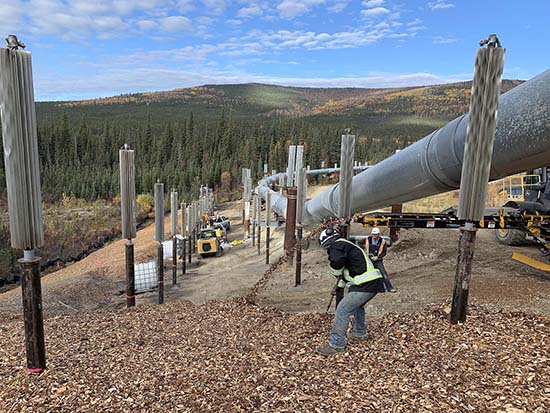|
Subscribe / Renew |
|
|
Contact Us |
|
| ► Subscribe to our Free Weekly Newsletter | |
| home | Welcome, sign in or click here to subscribe. | login |
Construction
| |
 |
March 28, 2022
National Finalist: Gold Award
Special Projects

Shannon & Wilson
Project: TAPS-Lost Creek thermal improvements
Client: Alyeska Pipeline Service Co.
The Trans Alaska Pipeline System is a 48-inch-diameter pipeline sending 500,000 barrels of oil per day from Prudhoe Bay to Valdez, Alaska. The pipeline traverses 800 miles of continuous and intermittent permafrost and is either supported above ground or buried, depending on subsurface conditions. In the 1970s, when the Trans Alaska Pipeline was originally built, no one anticipated that Alaska’s permafrost would soften, but continued climate-warming trends are causing problems with structures that support it.
Since 1990, the Alyeska Pipeline Service Co. has performed extensive maintenance at its remote Lost Creek site about three hours north of Fairbanks. Here complex soil and thermal conditions cause continuous slope movement and threaten a landslide that could disrupt the Trans Alaska Pipeline. Above ground, the pipeline is supported on vertical support members constructed with 18-inch-diameter steel pipe piles that extend 35 to 50 feet deep.
Unfortunately, the 40-foot fill embankment the Trans Alaska Pipeline sits on at Lost Creek was constructed over a frozen peat bog during the winter. After construction, a shear zone developed within the frozen permafrost peat layer, which displaces at about half an inch per year. This slope movement causes the pipeline’s vertical support members to tilt, putting stress on the pipeline.
Shannon & Wilson designed new piles to replace those with excessive tilt and a thermal improvement system to cool the peat zone to stop the creeping movement and prevent a rapidly moving landslide.
The thermal improvement system is an array of free-standing heat pipe thermosyphons drilled 40 to 60 feet into the ground and surface insulation to keep it cool. These thermosyphons provide long-term cooling in a completely passive manner, requiring no moving parts, pumps, or supplied power. Using locally available woodchips for surface insulation to prevent excessive heat gain during warm weather seasons creates a smaller carbon footprint.
Using state-of-the-art design methods, Shannon & Wilson geotechnical engineers significantly reduced the number of thermosyphons and amount of woodchip surface insulation needed to cool and maintain permafrost even with the most severe climate warming scenario. The innovative Lost Creek project design combined two emerging technologies (transient thermal creep testing and 3D finite element thermal simulation) and one existing technology (passive thermosyphons) to solve a costly and potentially dangerous problem.
Using new and more accurate 3D FE modeling software, Shannon & Wilson’s design provided a less costly and more efficient design that allowed construction to fit in one season instead of two. The final design saved over $1 million by using 40% fewer thermosyphons and incorporating units already in storage for maintenance, saving precious fabrication time.
With continued climate warming trends and consequent permafrost degradation, many other slopes in Arctic regions have similar problems. The Lost Creek thermal improvements project exemplifies engineering excellence, demonstrating that emerging and existing technology — applied in unique ways — can solve not only the issues of today but can provide new engineering solutions for the future.
Other Stories:
- National Finalist: Platinum award
Special Projects - National Finalist: Gold Award
Water Resources - National Finalist: Gold Award
Transportation - Best in State: Gold Award
Social, economic and sustainable design - Best in State: Gold Award
Complexity - Diversity and Inclusion Award: Mid-Size Firms
- Diversity and Inclusion Award: Large Firm
- Engineer of the Year
- Best in State: Gold Award
Social, economic and sustainable design - Best in State: Gold Award
Successful fulfillment of client/owner needs - Best in State: Gold Award
Future value to the engineering profession - Best in State: Gold Award
Future value to the engineering profession - Best in State: Gold Award
Unique or innovative application of new or existing techniques - Diversity and Inclusion Award: Mid-Size Firms
- National Finalist: Gold Award
Structural Systems


